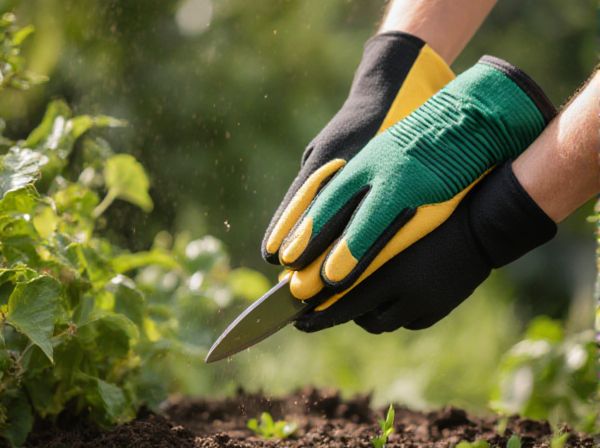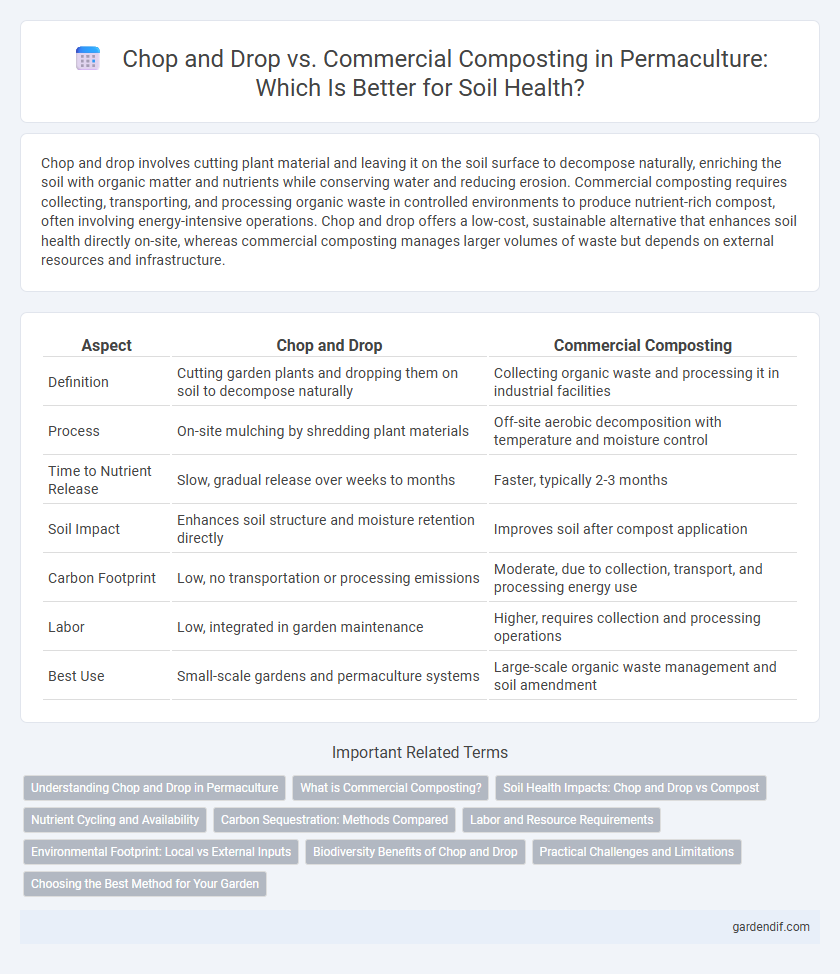
chop and drop vs commercial composting Illustration
Chop and drop involves cutting plant material and leaving it on the soil surface to decompose naturally, enriching the soil with organic matter and nutrients while conserving water and reducing erosion. Commercial composting requires collecting, transporting, and processing organic waste in controlled environments to produce nutrient-rich compost, often involving energy-intensive operations. Chop and drop offers a low-cost, sustainable alternative that enhances soil health directly on-site, whereas commercial composting manages larger volumes of waste but depends on external resources and infrastructure.
Table of Comparison
| Aspect | Chop and Drop | Commercial Composting |
|---|---|---|
| Definition | Cutting garden plants and dropping them on soil to decompose naturally | Collecting organic waste and processing it in industrial facilities |
| Process | On-site mulching by shredding plant materials | Off-site aerobic decomposition with temperature and moisture control |
| Time to Nutrient Release | Slow, gradual release over weeks to months | Faster, typically 2-3 months |
| Soil Impact | Enhances soil structure and moisture retention directly | Improves soil after compost application |
| Carbon Footprint | Low, no transportation or processing emissions | Moderate, due to collection, transport, and processing energy use |
| Labor | Low, integrated in garden maintenance | Higher, requires collection and processing operations |
| Best Use | Small-scale gardens and permaculture systems | Large-scale organic waste management and soil amendment |
Understanding Chop and Drop in Permaculture
Chop and drop is a sustainable mulching technique in permaculture where plant residues are cut and left to decompose directly on the soil, enhancing organic matter and moisture retention naturally. This process supports soil health by promoting microbial activity and nutrient cycling without the need for external inputs or transportation typical in commercial composting systems. Unlike commercial composting, chop and drop integrates organic waste management seamlessly into garden ecosystems, reducing labor and carbon footprint while improving soil structure.
What is Commercial Composting?
Commercial composting is an industrial process that breaks down organic waste, including food scraps and yard waste, at high temperatures to produce nutrient-rich compost on a large scale. Unlike chop and drop methods, which return plant material directly to the soil onsite, commercial composting involves controlled aerobic decomposition in specialized facilities to accelerate the breakdown and kill pathogens. This method efficiently manages large volumes of organic waste, producing consistent, high-quality compost suitable for agriculture and landscaping.
Soil Health Impacts: Chop and Drop vs Compost
Chop and drop, a permaculture technique, enhances soil health by directly returning organic matter to the soil surface, promoting microbial activity and improving moisture retention. In contrast, commercial composting decomposes organic waste off-site before application, potentially losing some nutrients and beneficial microbes during processing. Integrating chop and drop in permaculture systems supports richer soil biodiversity and faster nutrient cycling compared to relying solely on commercial compost.
Nutrient Cycling and Availability
Chop and drop in permaculture enhances nutrient cycling by directly returning organic matter to the soil, promoting immediate microbial activity and continuous nutrient availability. Commercial composting, while effective in breaking down waste, often results in nutrient loss through leaching and delays nutrient release due to processing time. Integrating chop and drop practices ensures a more efficient, localized nutrient cycle, boosting soil fertility and plant health.
Carbon Sequestration: Methods Compared
Chop and drop enhances carbon sequestration by returning organic matter directly to the soil, increasing soil carbon content and promoting microbial activity more effectively than commercial composting. This method reduces carbon emissions by minimizing transportation and processing energy typically associated with commercial compost facilities. Studies show that in situ decomposition of plant residues through chop and drop contributes to long-term soil carbon storage, supporting sustainable permaculture practices.
Labor and Resource Requirements
Chop and drop permaculture techniques minimize labor and resource inputs by naturally recycling organic matter on-site, reducing the need for external inputs and heavy equipment typical of commercial composting. Commercial composting requires significant labor for turning, monitoring temperature, and managing feedstock inputs, along with resources such as machinery and transportation to process organic waste. The chop and drop method promotes energy efficiency and sustainability, aligning with permaculture principles by optimizing local nutrient cycling with minimal effort.
Environmental Footprint: Local vs External Inputs
Chop and drop permaculture techniques minimize environmental footprint by recycling organic matter directly on-site, reducing the need for transportation and external inputs. Commercial composting often requires collecting, transporting, and processing organic waste off-site, increasing fuel consumption and associated carbon emissions. Utilizing local biomass through chop and drop supports soil health while significantly lowering the overall carbon footprint compared to external compost sourcing.
Biodiversity Benefits of Chop and Drop
Chop and drop mulching enhances soil biodiversity by providing a continuous, diverse organic matter source that supports a wide range of microorganisms, fungi, and beneficial insects. This natural decomposition process fosters a balanced ecosystem, promoting nutrient cycling and improving soil structure without the disturbance associated with commercial composting. Maintaining in-situ plant residues also creates microhabitats that increase habitat complexity and encourage diverse flora and fauna, essential for resilient permaculture systems.
Practical Challenges and Limitations
Chop and drop in permaculture minimizes labor and maintains soil moisture but can lead to uneven nutrient distribution and slower decomposition rates compared to commercial composting. Commercial composting offers faster organic matter breakdown and pathogen elimination yet requires space, equipment, and regular monitoring to manage temperature and moisture effectively. Incorporating both methods can balance efficiency and sustainability while addressing practical challenges such as pest attraction and nutrient leaching.
Choosing the Best Method for Your Garden
Chop and drop is a sustainable permaculture practice where garden residues are cut and left to decompose directly on the soil, enriching it with organic matter and enhancing microbial activity. Commercial composting involves collecting organic waste off-site for centralized processing, producing nutrient-rich compost that can be transported back to gardens but may require additional inputs like energy and transportation. Choosing the best method depends on garden size, labor availability, and ecological goals, with chop and drop favored for low-maintenance, soil health-focused systems and commercial composting suited for larger operations needing consistent compost quality.
chop and drop vs commercial composting Infographic

 gardendif.com
gardendif.com